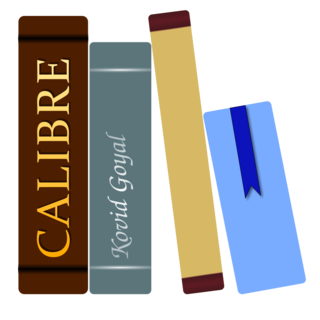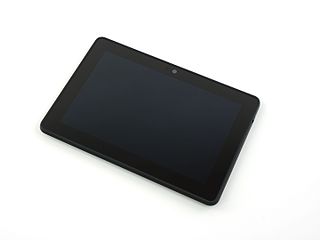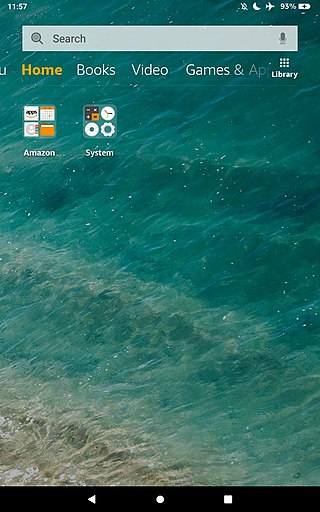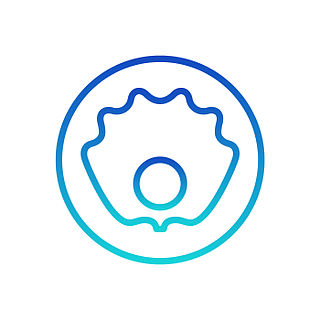Related Research Articles

A tablet computer, commonly shortened to tablet, is a mobile device, typically with a mobile operating system and touchscreen display processing circuitry, and a rechargeable battery in a single, thin and flat package. Tablets, being computers, have similar capabilities, but lack some input/output (I/O) abilities that others have. Modern tablets largely resemble modern smartphones, the only differences being that tablets are relatively larger than smartphones, with screens 7 inches (18 cm) or larger, measured diagonally, and may not support access to a cellular network. Unlike laptops, tablets usually run mobile operating systems, alongside smartphones.

An e-reader, also called an e-book reader or e-book device, is a mobile electronic device that is designed primarily for the purpose of reading digital e-books and periodicals.

Android is a mobile operating system based on a modified version of the Linux kernel and other open-source software, designed primarily for touchscreen mobile devices such as smartphones and tablets. Android is developed by a consortium of developers known as the Open Handset Alliance, though its most widely used version is primarily developed by Google. It was unveiled in November 2007, with the first commercial Android device, the HTC Dream, being launched in September 2008.
Amazon Kindle is a series of e-readers designed and marketed by Amazon. Amazon Kindle devices enable users to browse, buy, download, and read e-books, newspapers, magazines and other digital media via wireless networking to the Kindle Store. The hardware platform, which Amazon subsidiary Lab126 developed, began as a single device in 2007. Currently, it comprises a range of devices, including e-readers with E Ink electronic paper displays and Kindle applications on all major computing platforms. All Kindle devices integrate with Windows and macOS file systems and Kindle Store content and, as of March 2018, the store had over six million e-books available in the United States.

OverDrive Media Console was a proprietary, freeware application developed by OverDrive, Inc. for use with its digital distribution services for libraries, schools, and retailers. The application enables users to access audiobooks, eBooks, periodicals, and videos borrowed from libraries and schools—or purchased from booksellers—on devices running Android, BlackBerry, iOS (iPad/iPhone/iPod), and Windows, including Mac and Windows desktop and laptop computers.

Calibre is a cross-platform free and open-source suite of e-book software. Calibre supports organizing existing e-books into virtual libraries, displaying, editing, creating and converting e-books, as well as syncing e-books with a variety of e-readers. Editing books is supported for EPUB and AZW3 formats. Books in other formats like MOBI must first be converted to those formats, if they are to be edited.
Rooting is the process by which users of Android devices can attain privileged control over various subsystems of the device, usually smartphones. Because Android is based on a modified version of the Linux kernel, rooting an Android device gives similar access to administrative (superuser) permissions as on Linux or any other Unix-like operating system such as FreeBSD or macOS.
UltraViolet was a cloud-based digital rights locker for films and television programs that allowed consumers to store proofs-of-purchase of licensed content in an account to enable playback on different devices using multiple applications from several different streaming services. UltraViolet also allowed users to share access to their library with up to five additional people. UltraViolet was deployed by the Digital Entertainment Content Ecosystem (DECE), an alliance of 85 companies that includes film studios, retailers, consumer electronics manufacturers, cable television companies, internet service providers (ISPs), internet hosting vendors, and other internet systems and security vendors, with the notable exceptions of Walt Disney Studios, Google, Amazon and Apple.

The Nook Color is a tablet computer/e-reader that was marketed by Barnes & Noble. A 7-inch (18 cm) tablet with multitouch touchscreen input, it is the first device in the Nook line to feature a full-color screen. The device is designed for viewing of books, newspapers, magazines, and children's picture books. A limited number of the children's books available for the Nook Color include interactive animations and the option to have a professional voice actor read the story. It was announced on 26 October 2010 and shipped on 16 November 2010. Nook Color became available at the introductory price of US$249. In December 2011, with the release of the Nook Tablet, it lowered to US$169. On 12 August 2012, the price lowered to US$149. On 4 November 2012, the price was further lowered to US$139. The tablet ran on Android.

The Barnes & Noble Nook is a brand of e-readers developed by American book retailer Barnes & Noble, based on the Android platform. The original device was announced in the U.S. in October 2009, and was released the next month. The original Nook had a six-inch E-paper display and a separate, smaller color touchscreen that serves as the primary input device and was capable of Wi-Fi and AT&T 3G wireless connectivity. The original Nook was followed in November 2010 by a color LCD device called the Nook Color, in June 2011 by the Nook Simple Touch, and in November 2011 and February 2012 by the Nook Tablet. On April 30, 2012, Barnes & Noble entered into a partnership with Microsoft that spun off the Nook and college businesses into a subsidiary. On August 28, 2012, Barnes and Noble announced partnerships with retailers in the UK, which began offering the Nook digital products in October 2012. In December 2014, B&N purchased Microsoft's Nook shares, ending the partnership.

The Amazon Fire, formerly called the Kindle Fire, is a line of tablet computers developed by Amazon. Built with Quanta Computer, the Kindle Fire was first released in November 2011, featuring a color 7-inch multi-touch display with IPS technology and running on Fire OS, an Android-based operating system. The Kindle Fire HD followed in September 2012, and the Kindle Fire HDX in September 2013. In September 2014, when the fourth generation was introduced, the name "Kindle" was dropped. In later generations, the Fire tablet is also able to convert into a Smart speaker turning on the "Show Mode" options, which the primary interaction will be by voice command through Alexa.
A mobile application or app is a computer program or software application designed to run on a mobile device such as a phone, tablet, or watch. Mobile applications often stand in contrast to desktop applications which are designed to run on desktop computers, and web applications which run in mobile web browsers rather than directly on the mobile device.
The Nook Tablet is a tablet e-reader/media player that was produced and marketed by Barnes & Noble. It followed the Nook Color and was intended to compete with both e-book readers and tablet computers.
A digital newsstand is a digital distribution platform for downloadable newspapers, magazines and journals. Examples include Apple's Newsstand and Google Play Newsstand – both of which have been discontinued – Amazon Kindle Newsstand and Magzter. It is an online development of the traditional news stand.

The iPad Mini is a line of mini tablet computers designed, developed, and marketed by Apple Inc. It is a sub-series of the iPad line of tablets, with screen sizes of 7.9 inches and 8.3 inches. The first-generation iPad Mini was announced on October 23, 2012, and was released on November 2, 2012, in nearly all of Apple's markets. It featured similar internal specifications to the iPad 2, including its display resolution.

The Fire HDX, formerly named Kindle Fire HDX, was a high-end model in Amazon Fire line of tablet computers. It was announced on September 25, 2013, and was available in two models, 7 inch and 8.9 inch. The 7 inch WiFi model was released on October 18, 2013, and the 8.9 inch WiFi model was released on November 7, 2013, in the United States.

Fire OS is a mobile operating system based on Android Open Source Project (AOSP) source code. It is developed by Amazon for their devices. Fire OS includes proprietary software, a customized user interface primarily centered on content consumption, and heavy ties to content available from Amazon's storefronts and services.

Oyster was a commercial streaming service for digital e-books, available for Android, iOS, Kindle Fire, and NOOK HD/HD+ devices. It was also available on any web browser on a desktop or laptop computer. Oyster held over 1 million books in its library, and as of September 2015, the service was only available in the United States.

The iPad Mini 2 is a tablet computer produced and marketed by Apple Inc. It has a nearly identical design to its predecessor the first-generation iPad Mini, but features internal revisions such as the addition of the A7 system-on-a-chip and 2,048 x 1,536 resolution Retina Display. Internally, the second-generation iPad Mini has nearly the same hardware as its sibling device, the iPad Air. Apple released the second-generation iPad Mini in space gray and silver colors on November 12, 2013.

The first-generation iPad Mini is a mini tablet computer designed, developed, and marketed by Apple Inc. It was announced on October 23, 2012, as the fourth major product in the iPad line and the first of the iPad Mini line, which features a reduced screen size of 7.9 inches (20 cm), in contrast to the standard 9.7 inches (25 cm). It features similar internal specifications to the iPad 2, including its display resolution.
References
- ↑ Memetic, Daniel. "Escaping the Walled Gardens in the Clouds". Tech-FAQ.com. Retrieved 7 October 2012.
- ↑ Smith, Nicholas (2009). "Interview With Rosabeth Moss Kanter, author of SuperCorp (2009): No Matter How Big You Are, Diversify or Die". Ericsson.com Company Docs. Retrieved 7 October 2012.
- ↑ "Definition of: walled garden". PCmag.com. Retrieved 13 June 2012.
- 1 2 Eisenmann, Thomas R.; Parker, Geoffrey; Van Alstyne, Marshall (31 August 2008). "Opening Platforms: How, When and Why?" (PDF). Harvard Business School Entrepreneurial Management Working Paper No. 09-030. Harvard Business School. p. 2. doi:10.2139/ssrn.1264012 . Retrieved 30 June 2015.
- 1 2 3 4 5 Wu, Tim (2016). The Attention Merchants: The Epic Scramble to Get Inside Our Heads . New York: Penguin Random House. p. 210. ISBN 9780385352017.
- ↑ Mathew Ingram (29 February 2012). "How the e-book landscape is becoming a walled garden". Gigaom. Retrieved 7 October 2012.
- ↑ Jay Akasie (7 September 2012). "With New Kindle, Bezos Proves Ecosystems Matter More Than Hardware". Archived from the original on 11 September 2012. Retrieved 7 October 2012.
- ↑ Pascal-Emmanuel Gobry (18 October 2011). "How Amazon Makes Money From The Kindle; Amazon's Kindle is no longer just a product: It's a whole ecosystem". Business Insider. Retrieved 29 November 2013.
- ↑ Charles Arthur (17 April 2012). "Battle for the Internet (Part III of series): Walled gardens look rosy for Facebook, Apple – and would-be censors". The Guardian .
- ↑ Ben Bajarin (1 July 2011). "Why Competing With Apple is So Difficult". Time .
- ↑ Smith, Peter (21 December 2011). "Kindle Fire and Nook Tablet both get "upgraded" with reduced functionality". ITWorld.com. Retrieved 10 January 2012.
- ↑ Verry, Tim (21 December 2011). "Kindle Fire and Nook Tablet Receive Root Access Killing Software Updates". PCPerspective.com. Retrieved 10 January 2012.
- ↑ Carnoy, David (2 May 2013). "Barnes & Noble adds Google Play store to its tablets: The Nook HD and HD+ may not be fully "open" Android tablets, but they're now much more open than they were". CNet.
- ↑ "Encrypted Media Extensions". www.w3.org. Retrieved 11 July 2017.
- ↑ Permissioned blockchains are the virgin margaritas of cryptocurrency
- ↑ "We Are the App Store". Hacker News . Y Combinator . Retrieved 29 November 2013.
- ↑ Martin Adolph of ITU’s Telecommunication Standardization Bureau (TSB) (2011). "The world of video games: Trends in video games and gaming". ITU News (10).
- ↑ Robert A. Burgelman; Carrie C. Oliver (1 August 1997). "Electronic Arts in 1995". Stanford Graduate School of Business. pp. 16 pages. SM24-PDF-ENG. Retrieved 29 November 2013.
- ↑ Liao, Rita (8 October 2022). "Elon Musk's X app for 'everything' might be a non-starter in the US". TechCrunch. Retrieved 28 October 2022.